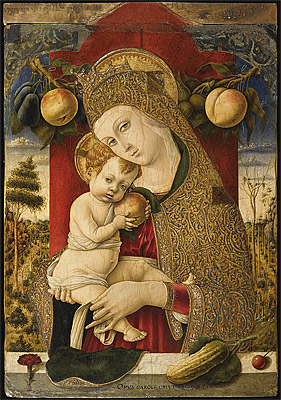
BartolomeoMontagna was an Italian Renaissance painter who mainly worked in Vicenza. He also produced works in Venice, Verona, and Padua. He is most famous for his many Madonnas and his works are known for their soft figures and depiction of eccentric marble architecture. He is considered to be heavily influenced by Giovanni Bellini, in whose workshop he might have worked around 1470. Benedetto Montagna, a productive engraver, was his son and pupil and active until about 1540. He was mentioned in Vasari's Lives as a student of Andrea Mantegna but this is widely contested by art historians.

Carlo Crivelli was an Italian Renaissance painter of conservative Late Gothic decorative sensibility, who spent his early years in the Veneto, where he absorbed influences from the Vivarini, Squarcione, and Mantegna. He left the Veneto by 1458 and spent most of the remainder of his career in the March of Ancona, where he developed a distinctive personal style that contrasts with that of his Venetian contemporary Giovanni Bellini.

Giovanni Battista Cima, also called Cima da Conegliano, was an Italian Renaissance painter, who mostly worked in Venice. He can be considered part of the Venetian school, though he was also influenced by Antonello da Messina, in the emphasis he gives to landscape backgrounds and the tranquil atmosphere of his works.

The Pinacoteca di Brera is the main public gallery for paintings in Milan, Italy. It contains one of the foremost collections of Italian paintings from the 13th to the 20th century, an outgrowth of the cultural program of the Brera Academy, which shares the site in the Palazzo Brera.

VittorioCrivelli was an Italian painter and brother of Carlo Crivelli. His works are similar in style to his brother's, but less accomplished.
The decade of the 1480s in art involved some significant events.

The Madonna with Child is a tempera and gold on panel painting, transferred to canvas, by Renaissance artist Carlo Crivelli. It is a Madonna painting dating to c. 1470.

The Pinacoteca del Castello Sforzesco is an art gallery in the museum complex of the Castello Sforzesco in Milan, northern Italy.

Madonna and Child with Saints and Donor is a c. 1490 oil on panel painting by Carlo Crivelli. It shows the Madonna and child between Francis of Assisi and Bernardino of Siena, with a tiny figure of the painting's donor kneeling on the balustrade in front of the Madonna. It is stored at the Walters Art Museum in Baltimore.

The St Peter Martyr Altarpiece or Minor San Domenico Altarpiece is a altarpiece in tempera and gold on panel by the Italian Renaissance painter Carlo Crivelli, executed c. 1476. Its central panel of the Madonna and Child, signed "OPVS CAROLI CRIVELLI VENETI", is now in the Museum of Fine Arts in Budapest. The altarpiece's other panels were seen in Rome by Luigi Lanzi in 1789 before being moved to Florence with the Rinuccini family. In 1868 it moved from the Demidov collection to the National Gallery in London, where they still hang.

The 1476 Altarpiece or San Domenico Altarpiece is a 1476 tempera and gold on panel altarpiece by Carlo Crivelli. Its central panel of the Pietà is now in the Metropolitan Museum of Art in New York, whilst the other nine are now in the National Gallery, London.

Adoration of the Shepherds is a c. 1480 tempera and gold on panel painting by the Italian painter Carlo Crivelli. It is now in the Museum of Fine Arts in Strasbourg, for which it was acquired in Florence by Wilhelm von Bode. Its inventory number is 171. Art historians are uncertain about the dating of the painting, and propositions have ranged from 1470 to 1491.

The Lochis Madonna is a tempera and gold on panel painting by Carlo Crivelli, executed c. 1475, and signed OPVS CAROLI CRIVELLI VENETI. It is now in the Accademia Carrara, in Bergamo, which it entered in 1866 from Guglielmo Lochis' collection - its previous history is unknown.

Madonna and Child is a tempera and gold on panel painting by Carlo Crivelli, executed c. 1480, and signed OPVS CAROLI CRIVELLI VENETI. It is now in the Pinacoteca civica Francesco Podesti in Ancona. Its dating has varied on stylistic grounds between the 1470s and 1480s, close in date to the artist's Lenti Madonna and Madonna and Child with an Apple.

The Lenti Madonna or Bache Madonna is a tempera and gold on panel painting by the Italian Renaissance painter Carlo Crivelli, executed c. 1472–1473, and signed OPVS KAROLI CRIVELLI VENETI. It is now in the Metropolitan Museum of Art in New York, which it entered in 1944.

The Huldschinsky Madonna is a tempera-and-gold-on-panel painting by Carlo Crivelli, executed c. 1460, and signed "OPVS KAROLI CRIVELLI VENETI". It is now in the San Diego Museum of Art. It is dated early in the artist's career, during or just after his stay in Padua in Francesco Squarcione's studio. There is a copy of the work with several variations signed "Opus P. Petri", who Roberto Longhi argued to be Pietro Calzetta, another Paduan School painter.

The Porto San Giorgio Altarpiece or Porto San Giorgio Polytpych was a 1470 multi-panel tempera and gold on panel altarpiece by the Italian Renaissance painter Carlo Crivelli. Stylistically similar to Crivelli's Massa Fermana Altarpiece, the work was a fundamental step in his evolution away from the Paduan Renaissance towards a more delicate and realist style.

A cartellino is an illusionistic portrayal of a written note included in painting, mostly from the with a legend that records the name of the artist, the date, the subject, or some other relevant information about the work. About 500 Renaissance paintings include a cartellino, but the device has been adopted by some later artists.

The Madonna and Child with an Apple is a 1482 tempera and gold on panel painting by Carlo Crivelli, probably originally painted in Camerino and now divided between the Pinacoteca di Brera, in Milan, the Stadel Museum, in Frankfurt, and the Abegg-Stockar Collection, in Zürich.


















